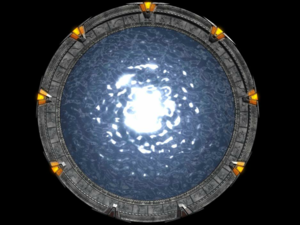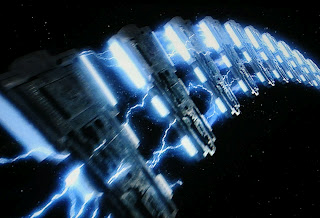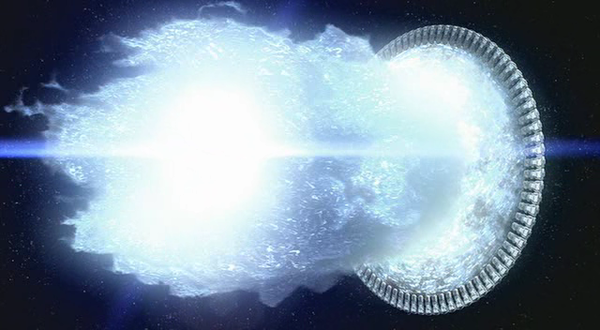
The Stargate is a ring shaped object that is constructed from a super conductive material that acts as a high energy capacitor and generates a wormhole directed at another Stargate. The gate translates matter into energy, broadcasts that energy through the wormhole where it is converted back to matter with its relative speed, force, orientation, and direction of travel intact. The use of the gates has been confirmed effective after Damien Smith worked out a computer interface to the gates and as such the Stargate Construction Project is underway to work out a method of producing more gates.
Origin
What is known about the devices comes largely from records found aboard a derelict vessel on the edge of Federations pace in 2380. The database aboard the vessel was very clear about the Stargates, their purpose, where notable gates were found, what powers them, etc.. Though the research done suggests a roughly 20th century knowledge of physics some data compiled suggests outside help from more advanced life forms.
Discovered with the Stargate was a vessel called the Daedalus which appears to originate from an alternate reality or parallel dimension. It contained a vast database on the operation, theories, and specifications of devices known as Stargates. On board the Daedalus was also a cache of these devices, totally 47 gates in all, all of which were Type III gates with removable thruster pods for maintaining stable locations within space. The database also indicated that the gates were being moved for some kind of experiment in creating a massive time-bubble.
While the mechanics are unclear, it appears the experiment was designed to use multiple gates for controlled time travel. The Daedalus appeared to have been storing gates to use as some kind of reserve or backup in case the Stargates were damaged or destroyed in the experiment.
Theories
A lot of speculation about how these devices came to be in the Milky Way Galaxy have been proposed. From the data provided by the Daedalus computer the favored explanation is that during an experiment to use the gates to generate an artificial bubble of time and thus travel through time intentionally, it is very likely that the experiment failed in some kind of catastrophic way.
The computer database does not mention why this endeavor was undertaken in the first place. Even without this information it is clear that significant resources were in use to make the attempt which would suggest some urgency on the matter. The computer has a limited amount of sensor data about the attempt, where the Daedalus was apparently near one terrestrial gate locations when the experiment failed. This limits information strongly suggests that the field collapsed in a full subspace field inversion. Such an inversion would have had the potential to not only destroy the gates, at the power levels indicated, but also distort the fabric of reality enough to cause nearby vessels or even planets to be displaces in space, time, and even quantum reality.
Conclusions
It is clear that the gates and the vessel are not native to the Milky Way Galaxy and may not even be native to this particular quantum reality. Testing of the materials indicates that gates, the ship, and other materials found do not match the quantum signature of this reality and vibrate on a slightly different quantum resonance frequency. The element the gates are made of, does not appear on our periodic table at all which suggests that the physical laws might differ in some way from this universe or that we have yet to discover the element in question, which may be naturally occurring but not within known space.
Due to these uncertainties, it is possible that other artifacts involved in the experiment also exist and were moved into this reality. Since a large portion of our galaxy is unexplored, we may find more gates, ships, or similar artifacts that are not native to this reality.
Power Source
A Stargate acts as a capacitive superconductor, the material it is made of can be synthesized by is not known to occur naturally in the Milky Way. The discovered database refers to it was Naquada (N-a-quid-ah). The gate can be powered either by an attached device which appears to control the gate mechanism and allow for the gate to either be powered from this "DHD" or the remote DHD. How the DHD's generate or store power is not specified. Dialing between galaxies requires exponentially more power than within a galaxy. The database refers to a "Zero Point Module" or ZPM as the power source for such activities which appears to output power into the exawatt range or higher.
Normal operation of the Stargate and its associated power sources limit a wormhole to 38 minutes, according to the database. References are made on a few occasions to a wormhole being open for much longer - in the case of the Supergate the quantum singularity appeared to be able to power the gate indefinitely. The database theorized that the power output required to maintain a wormhole connection after 38 minutes became beyond many multiple ZPM's to generate.
The database contained no detailed construction data nor any actual ZPM's for study but were said to have a power output of 1,000,000,000 EW (exawatts) or about 28% the total power output of the sun. For comparison purposes the maximum output of an Intrepid class starship warp reactor is roughly 64 MW and similarly a Galaxy Class starship can produce around 1000 TW at maximum power.
Operation
The gate is operated by "dialing" a set of coordinates via what the database refers to as a "Dial Home Device" or DHD. The coordinates are specified by "chevrons" which symbolize remote constellations or star groupings. These groupings form 6 symbols specifying 6 points who intersect at a particular location, a seventh symbol marks the point of origin for the wormhole this constitutes a dialing address. An 8th symbol can be added to the address which can dial a gate outside the galaxy, not all gates are capable of understanding such a sequence. Finally, a 9th symbol has been successfully dialed 3 times requiring incredible amounts of power. This 9th symbol appears to be an arbitrary address that connects a wormhole with an abandoned vessel known as Destiny. The records are unclear on the purpose of the vessel but this is where the Type I gate was discovered.
The gate symbols offer a robust method of controlling a wormhole without requiring a need to understand how to direct a wormhole to a target location. Wormholes are opened using two or more loci along the plane of the gate generating the wormhole, these determine the geometry of shape, distance, and elasticity of the wormhole required to form a stable connection. By using symbols to calculate these values the Ancients devised a robust way for lamens to use the gate network without technical expertise.
9th Symbol
The "9th Symbol" dialing address also required more power than a ZPM could produce and was only powered by using the combined energy from a planet both rich in deposits of naquida and with a high degree of solar and geothermal energy. Only when the solar and geothermal energy was used to generate power from the naquida deposits and then harnessed was it able to power the gate to connect to the 9th symbol. The database is unclear on how exactly this was done, but it was clear on the fact that the power output destabilized the planets core in each of the three attempts and destroyed the planet every time.
Gates & Symbols
Each gate and its corresponding DHD would normally have a unique symbol which specifies as point of origin. This ties a DHD to a specific gate. The 6 other symbols are stars or other stellar phenomena which can be easily located by the gate network, and are used to calculate the precise focal point and subspace distortion required to open a gate to a particular destination. Similarly the 8 symbol address uses a symbol for a particular galaxy (and thus its network) calculate the distance between an origin gate and a destination gate in another galaxy using only the local gate symbols.
Solas Tempus Operation
Overall the gates use a similar principle in Solas Tempus. However, with help of the Avali the gates have been altered so that they allow both matter and energy to pass both ways through the wormhole and the origin gate does not need a gate at a destination to operate.
Solas Tempus relies more heavily on the computers to control the gates. While each gate does have a 7-symbol address which is used to go from one gate to another, the system also allows for a gate to be directed using distance and bearing coordinates to direct a wormhole to a specific point in space using two angle bearings from the point of origin and a distance value to the destination, a total of 3 values. This is relative, and Solas Tempus also uses galactic coordinates to pinpoint a location in space relative to galactic center, which is the accepted standard for interstellar navigation.
Subspace beacons and the subspace radio network provide additional support to supply more precise information since stellar objects are in motion relative to each other, the system also provides the ability to simply name a destination location by it's proper name or terrestrial / local coordinates there in. The controlling computer handles the conversion to the specific wormhole geometry loci to form a stable wormhole to that location. This computer also provides safety checks to ensure a wormhole can be created safely. It has been learned from researching the database found with the gates that the gates themselves do actually do this but offer nothing in the way of error codes or other ways to troubleshoot what is actually happening. The Solas Tempus system offers robust reporting of problems and safety protocols to prevent dangerous usage. Gate travel can be accessed via standard communication systems making it similar to the Hyperspace Jump Gate system.
Transporter Compatibility
In theory it may also be possible to use the artificial wormhole to establish a transporter lock through the gate because the database shows specifically that energy can travel both ways through an active wormhole while matter cannot. Because a transporter converts matter to energy for transit, it may be possible to overcome this limitation with appropriate steps.
Types I, II, and III
A Type I, II, and III Stargate has a diameter of 4.6 meters.
There are four known types of Stargates. The first three are different versions of the same essential form factor and design. They are designed primarily of personnel transport between remote locations and can be placed nearly anywhere, aboard a ship, space station, on a planet, or even in orbital space. The Type I Stargate was the last to be discovered but proved to be the earliest design. Limited range compared to the others gates of this type appeared to be placed on planets via some kind of automated scheme prior to colonization of a particular galactic region. In this version the gate is "dialed" to a specific location by rotating the entire gate structure inside its mounting on some platform. The Type II gate is said to have been discovered first on Earth in the early 20th century via a dig in Egypt. While no evidence of this occurring was found in historical records, other evidence suggests that it may have happened in a parallel universe or alternate time-line. This appears to be a more finalized version of the Type I with a range only limited by power supply, constellation glyphs on the rings surface do suggest they were designed based on star groupings seen from Earth though this is inconclusive. Dialing of the gate appears to be done through rotating an inner ring where the symbols are found. The Type III gate is more advanced still, manual dialing in the same method of the Type I and II is not possible in this design and some computer interface is needed. Symbols are less pronounced here and more suggestive of star groupings rather than symbols derived from constellations. These groupings do not match any found in the Milky Way galaxy.
-
Type I Stargate
-
Type II Stargate
-
Type III Stargate
Type IV Stargate (Galactic / "Supergate")
The final and most impressive gate type is the Type IV known in the discovered database as a "Supergate" which is limited in size by only two factors - its power source and the number of "blocks" used to create the ring which forms the wormhole. The gate itself is formed by blocks which are linked by a powerful energy field. Each block forms a link and a part of the subspace field which opens a wormhole. The database specifies that the only thing powerful enough to power such a gate is a contained quantum singularity. The database does not have data on how a singularity is contained other than a mission report that specifies a vessel known as the Prometheus which witnesses a gate formed by a force field surrounding a planet that contracts the planet into a singularity, the same force field then contains and somehow harnesses that singularity for power.




